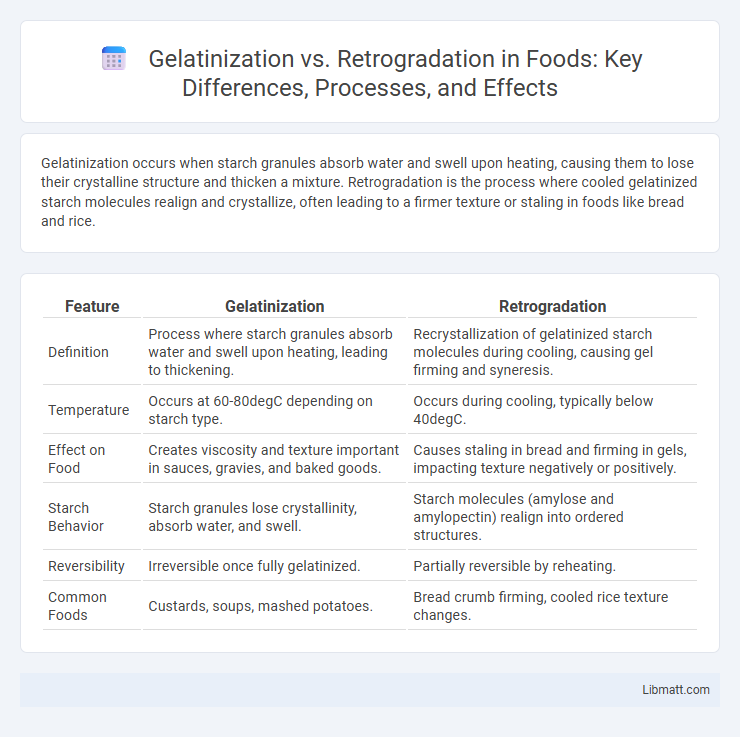Gelatinization occurs when starch granules absorb water and swell upon heating, causing them to lose their crystalline structure and thicken a mixture. Retrogradation is the process where cooled gelatinized starch molecules realign and crystallize, often leading to a firmer texture or staling in foods like bread and rice.
Table of Comparison
| Feature | Gelatinization | Retrogradation |
|---|---|---|
| Definition | Process where starch granules absorb water and swell upon heating, leading to thickening. | Recrystallization of gelatinized starch molecules during cooling, causing gel firming and syneresis. |
| Temperature | Occurs at 60-80degC depending on starch type. | Occurs during cooling, typically below 40degC. |
| Effect on Food | Creates viscosity and texture important in sauces, gravies, and baked goods. | Causes staling in bread and firming in gels, impacting texture negatively or positively. |
| Starch Behavior | Starch granules lose crystallinity, absorb water, and swell. | Starch molecules (amylose and amylopectin) realign into ordered structures. |
| Reversibility | Irreversible once fully gelatinized. | Partially reversible by reheating. |
| Common Foods | Custards, soups, mashed potatoes. | Bread crumb firming, cooled rice texture changes. |
Introduction to Gelatinization and Retrogradation
Gelatinization occurs when starch granules absorb water and swell upon heating, breaking their crystalline structure and increasing viscosity, which is essential in cooking and food processing. Retrogradation happens during cooling, where gelatinized starch molecules reassociate and realign, causing the texture to firm and sometimes leading to staling in baked goods. Your understanding of these processes can improve control over food texture and shelf life in various culinary applications.
Defining Gelatinization: What Happens to Starch?
Gelatinization involves the disruption of starch granules when heated in water, causing them to swell and absorb water, leading to the thickening of the mixture. During this process, the crystalline structure of starch breaks down, releasing amylose and amylopectin molecules into the solution. This transformation enhances the starch's ability to form gels and modifies its texture in food applications.
The Science Behind Starch Gelatinization
Starch gelatinization occurs when starch granules absorb water and swell upon heating, causing the crystalline structure to break down and form a gel-like consistency. This process transforms starch from an ordered, semi-crystalline state into an amorphous, viscous network, essential for texture in cooking and food processing. The temperature range for gelatinization varies by starch source but typically lies between 60degC and 80degC, triggering the loss of birefringence and enabling water-starch interactions.
Factors Affecting Gelatinization
Temperature, water content, and starch type are key factors affecting gelatinization, with higher temperatures and sufficient water enabling starch granules to swell and rupture. The presence of sugar, lipids, and acids can modify the gelatinization temperature and degree, while the amylose to amylopectin ratio significantly influences gelatinization behavior. Understanding these factors helps you control texture and consistency in food processing and preparation.
Retrogradation: The Reverse Process Explained
Retrogradation is the process where gelatinized starch molecules, primarily amylose and amylopectin, realign and reassociate as the mixture cools, leading to the firming or staling of foods like bread and cooked rice. This reversal impacts the texture and shelf life of starch-based products by increasing crystallinity and reducing water-holding capacity. Understanding retrogradation can help you control food quality and optimize texture in cooking and food storage.
Factors Influencing Retrogradation
Retrogradation is influenced by factors such as the type of starch, amylose content, temperature, and moisture levels, with higher amylose starches generally retrograding more quickly due to their linear molecular structure. Storage conditions like refrigeration accelerate retrogradation by promoting the reassociation of amylose and amylopectin molecules, leading to changes in texture such as staling in bread. Understanding these factors helps you control and predict the quality and shelf life of starch-based foods.
Key Differences Between Gelatinization and Retrogradation
Gelatinization is the process where starch granules absorb water and swell upon heating, leading to the disruption of crystalline structures and increased viscosity. Retrogradation occurs when gelatinized starch molecules, primarily amylose and amylopectin, realign and recrystallize during cooling, causing gel contraction and syneresis. The key difference lies in gelatinization being a heat-induced swelling and disruption phase, while retrogradation is a cooling-induced re-association of starch molecules, impacting texture and shelf-life in food products.
Impact on Food Texture and Quality
Gelatinization transforms starch granules into a gel-like structure, enhancing the texture and moisture retention of foods such as bread, sauces, and puddings. Retrogradation, the recrystallization of starch molecules during cooling, causes staling and textural firmness, often leading to undesirable hardening in baked goods and cooked rice. Understanding the balance between gelatinization and retrogradation helps you optimize food quality by controlling texture, shelf life, and sensory attributes.
Applications in Cooking and Food Processing
Gelatinization transforms starch granules into a thickened gel during heating, critical in making sauces, custards, and baked goods to achieve desired texture. Retrogradation occurs as gelatinized starch cools and rearranges, causing firmness and potential syneresis, influencing product shelf life and texture in refrigerated foods like bread and puddings. Controlling these processes optimizes quality in frozen, chilled, and processed foods by balancing moisture retention and texture stability.
Conclusion: Understanding Starch Transformation
Understanding starch transformation involves recognizing gelatinization as the process where starch granules absorb water and swell, leading to a viscous paste formation during heating. Retrogradation occurs when gelatinized starch molecules realign and expel water upon cooling, resulting in gel formation and firmness. Mastery of these processes is essential for optimizing texture and shelf life in food products containing starch.
Gelatinization vs Retrogradation Infographic

 libmatt.com
libmatt.com